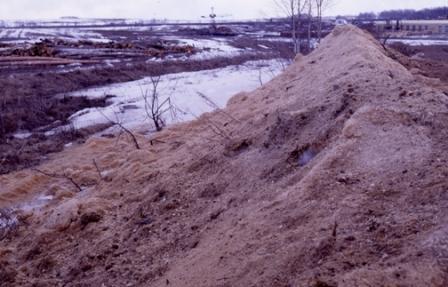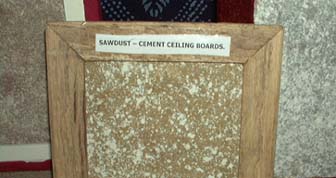 |
|
|
|
|
|
|
||||
|
In central Europe cattle are usually kept in stalls with slatted floors. In comparison with straw sawings offer definite advantages as bedding material. They can be easily be disposed as part of liquid manure, moreover, the do not block the spaces between the slots. Certain disadvantages have been reported: especially as far as dairy cows are concerned. Sharp pointed sawings can cause injury to cows´ teats and lead to streptococcal infections. It is therefore recommended that only softwood sawings/ shavings may be used, which is dry and lacking splinters. Like straw, sawings are also widely used in horse stables. Of particular importance is the high level of absorbency provided by dry shavings; furthermore as they can be pressed into bundels, they require less storage space than straw. (Example) They are, however, somewhat more expensive and the waste disposal can cause problems since farmers and mushroom growers are often hesitant to accept such“wooden” manure.
In Germany in 2001 there were a total of 6.9 million cats, making them the most popular pet. This number is still growing. In the year 2002 cat litter with its 189 million € in sales holds the largest market share among “commodities” for pets . This market is dominated by mineral based materials, however manufacturers have noted a tendency toward the use of wood based products which are said to be more “ecological”. (Example)
Through the production of edible fungi low value wood material (sawdust, small pieces of stems) can be transformed into high value food. This can be done in a very efficient way: When growing shiitake (Lentinula edodes) intensively under controlled conditions (defined substrate composition, temperature, humidity, light) the fresh weight of mushrooms produced can reach 70– 100 % of the dry mass of the wood comsumed. A detailed description on the cultivation of shiitake (Lentinula Edodes) on synthetic logs you can find here: http://www.mushroomcompany.com/200108/shiitake.pdf Large increases can be expected because it has only been possible to cultivate a few basidiomycetes (mainly Agaricus, Lentinus, Pleurotus, Auricularia, Volvariella, Flammulina and Tremella) up to now. In many cases it is still not known how the fruiting body development can be induced. When this question is solved, more species can be used and the overall production will further increase. About 200 years ago it was found that the large molecular carbohydrates in wood, namely cellulose and hemicellulose, can be fractionised by acid treatment into simple sugars (glucose, hexose and pentose) and thus converted to food. Because of the huge investments necessary to build production facilities, this has only made sense economically in times of need . But as ruminants are able to utilise cellulose through encymatic solubilisation, studies have been carried out to establish whether wood products could be used in addition to grass and other feeds. Experiments with fermented or acidified wood flour (see 7.) have been successful. In India, for example, a suitable solid state fermentation process has been developed to enhance the biological composition and nutrition value of sawdust using Pleurotus sajor-caju (springerlink). Cellulose made from sawdust can possibly be used as feed if it is carefully derived and finely ground .
Sawmill by-products have not only been used directly and indirectly for the production of food stuffs but have, for centuries, also been used to help conserve them and to improve their taste.
An interesting use of sawmill by-products in construction is demonstrated by wall form units made of low-density cement-bonded wood fiber composite. "It is composed of specially graded recycled waste wood (100% clean, natural softwood lumber) that is neutralized and mineralized and then bonded together with Portland cement. This material is lightweight with an adequate carrying capacity, porous, thermal insolating and very durable. It does not rot nor decay. It is vermine, termite and insect proof and does not support fungus growth. It is accepted as environmentally friendly and does not contain nor emit any toxic elements." (source; other example) When producing this material it care has to be taken that the wood being used is compatible with cement. If its sugar content is too high, it can be reduced by first subjecting the sawdust to fermentation. - The use of a mixture of sawdust, sand and cement for making wall panels has been fairly common in parts of Australia and other countries for many years. One possibility for using sawings and sawdust for environmental protection purposes is to mix it with materials which are to be composted, e.g. manure. In the composting of sewage sludge wooden particles serve as structural material. Its main function is to help adjust the water content of the rotting mixture to an optimal value and to increase the volume and stability of the pores.
A mixture of wood chips and compost can be used as biofilter to treat odorous air. A well-managed biofilter can reduce odor emissions by 85%, hydrogen sulfide by 90% and ammonia by around 60%.(source)
A Japanese company is offering a fast fermentation system for sewage sludge using wood chips as a kind of catalyst. To reduce the consumption of water and the production of sewage sludge sawdust toilets can be helpful.
On the other hand a recent study of DŁnisch et al. (2007), conducted in Germany and Brazil, demonstrated the potential of wood residues (chips and flour from Pinus sylvestris, Pinus taeda and Cordia goeldiana) as suitable raw materials for the development of new products for soil amelioration. Pellets containing a mixture of solid wood, ash, and charcoal residues impregnated with nutrients could be developed to increase the cation exchange capacity and thereby the efficiency of the application of mineral fertilizers. So waste from wood processing and burning facilities could be be used to reduce leaching of nutrients into the groundwater and to stabilize the chemical soil conditions in long term.(springerlink) An indirect way of environmental protection is if sawdust substitutes for sphagnum peat in horticultural applications (example 1, example 2). Generally there is an ongoing research on the potential of wood/ charcoal residues for soil amelioration (springerlink). For approximately 100 years wood flour has been produced by either sieving sawdust and/or finely grinding sawings, shaving or pieces of wood. Because of the very high standards which have to be met in the production of wood flour products, the raw material must be carefully selected and processed according to strict guidelines.
References:
|
||||||||||||||||||||||||||||||||||||||||||||||
|
|
|
|


